Craig
The small town of Craig is located between two of the best known saltwater sportfishing ports in Canada and Alaska. Langara Island, long fabled for it’s spectacular king salmon fishing, is situated just to the south of Craig and Sitka is the next stop to the north. With essentially all of the runs of west coast king salmon streaming down the coast each summer from Sitka and the Gulf of Alaska it’s no suprise that Craig has become a favored port for anglers wishing to pursue trophy saltwater king salmon, as well as silvers, halibut, ling cod, and bottomfish.
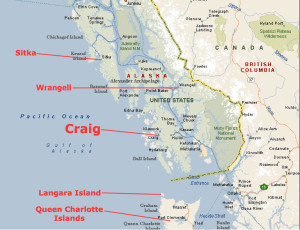 Unlike some of the larger sportfishing ports in Alaska, however, Craig is still a somewhat small, sleepy town of less than 2,000 year round residents. Situated on the west side of Prince of Wales Island Craig offers hardcore saltwater anglers a shot at the millions of king, silver, pink, sockeye, and chum salmon that pass by every summer. In addition, Craig has excellent halibut and bottomfishing for anglers looking to catch their own fish and chips. What you won’t find in Craig are hordes of tourists picking thru waterfront jewelry and gift shops or cruise ships towering over the town. The majority of the people you’ll find in Craig are there to fish, and that’s about it. Once you hang your hat in Craig for a while you’ll get accustomed to the same “island style” feeling you get on some of the tropical South Pacific islands. In short, Craig is the “real” Alaska.
Unlike some of the larger sportfishing ports in Alaska, however, Craig is still a somewhat small, sleepy town of less than 2,000 year round residents. Situated on the west side of Prince of Wales Island Craig offers hardcore saltwater anglers a shot at the millions of king, silver, pink, sockeye, and chum salmon that pass by every summer. In addition, Craig has excellent halibut and bottomfishing for anglers looking to catch their own fish and chips. What you won’t find in Craig are hordes of tourists picking thru waterfront jewelry and gift shops or cruise ships towering over the town. The majority of the people you’ll find in Craig are there to fish, and that’s about it. Once you hang your hat in Craig for a while you’ll get accustomed to the same “island style” feeling you get on some of the tropical South Pacific islands. In short, Craig is the “real” Alaska.
People don’t come to Craig to lay around in hammocks sipping Pina Colada’s, however, they come here to fish some of the most productive waters in all of Southeast Alaska. Whether it’s fishing amongst the quiet, undeveloped islands that separate Craig from the ocean or drifting the ocean itself, the waters west of Craig offer a gazillion options for soaking a bait and catching fish.
King Salmon
Feeder king salmon are available year round, but the real action starts here around the first or second week of June when the king migration gets into full swing. Generally speaking, the majority of the trophy king salmon, those being fish over 50 pounds, will be taken at in-shore locations like Pineapple Rock, Cape Ulitka, Granite, The Tree Hole, and Hawg Rock to name just a few. Water depths ranging from 50 to a little over 100 feet are the norm at these haunts and the holding areas at many of these locations can be little larger than a baseball infield, making for stiff competition. Bait, structure, and currents draw large fish to these areas each and every year and fish in the 50’s, 60’s, and even 70’s are taken from these areas on a yearly basis. Trophy kings are certainly caught elsewhere, but the majority of the anglers and charter captains searching for a wall hanger king will work these areas relentlessly.
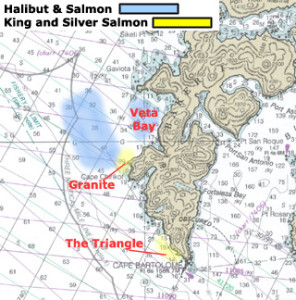
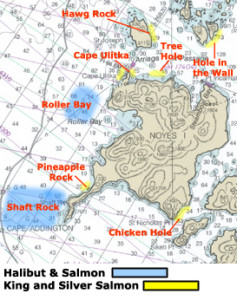
The areas around Noyes and Baker Island provide excellent fishing throughout the summer months.
If there were a slightly more productive time to catch a trophy king it would likely be from the last week of June thru the end of July when the large Skeena strain of kings are moving thru. Trophy class kings are caught throughout all of June, July, and into early August, however. Working the kelp lines and structure at any of the areas previously mentioned with a well-spun cut plug herring can put you face to face with a slab king any day of the week throughout much of the summer.
With trophy class kings available hooks need to be sharp, bait fresh, line and leaders free of frays, and rods and reels need to be in top working order. There’s nothing like hooking up with one of these explosive beasts to loose it to a gear malfunction. This is, after all, the big leagues of king salmon fishing.
Trophy class king salmon make up a very small percentage of the overall run, however, and the majority of the kings will average in the mid-twenty pound range. Though there’s certainly a mystique about catching a wall-hanger sized king, the smaller kings don’t lack in fighting ability and seldom under perform. They’re every bit as explosive as they’re larger brethren and long, blistering runs are the norm. For sheer numbers of mid-sized schooling kings offshore drifts like Roller Bay, Granite, and Shaft Rock can be tough to beat early in the season. As the numbers of kings pile up in these drifts toward the end of June multiple hookups can be the norm instead of the exception and it isn’t uncommon to see boats with 3 or 4 kings on at once.
Water depths in the offshore king salmon drifts often range from 225 to 280 feet, with the kings usually holding nearer to the bottom than the surface. Line counter reels like the Shimano Tekota are an effective tool for directing baits to fish holding deep, as baits can be dropped precisely to salmon marked on the fish finder. The additional advantage of using a line counter reel is that baits can also be stopped before reaching the bottom, where hordes of undersized chicken halibut can chew thru a days supply of bait and leaders in a hurry.
Silver Salmon
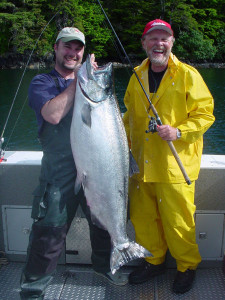 While the majority of the king salmon passing by Craig in the summer are heading for rivers further south, it’s estimated that at least half of the silvers caught are headed for local rivers in Southeast Alaska. Sporadic silver action will start taking place in late June or early July and generally by the second or third week of July the large schools of silvers cruising well offshore will begin to move toward the coast. Offshore drifts like Roller Bay, Granite, and Shaft Rock will see action first and then as the summer moves on silvers will be found at Pineapple, the Triangle, Tree Hole, Hawg Rock, Hole in the Wall, Rock Pile, The Chicken Hole, and a plethora of other areas between Craig and the ocean.
While the majority of the king salmon passing by Craig in the summer are heading for rivers further south, it’s estimated that at least half of the silvers caught are headed for local rivers in Southeast Alaska. Sporadic silver action will start taking place in late June or early July and generally by the second or third week of July the large schools of silvers cruising well offshore will begin to move toward the coast. Offshore drifts like Roller Bay, Granite, and Shaft Rock will see action first and then as the summer moves on silvers will be found at Pineapple, the Triangle, Tree Hole, Hawg Rock, Hole in the Wall, Rock Pile, The Chicken Hole, and a plethora of other areas between Craig and the ocean.
Dropping from 5 ounces of lead down to 4 ounces and changing lead colors from orange to chartreuse will typically produce a few more silvers, though when the bites on it seems like just about anything will catch them. Some days silvers will slam anything in sight and on others they can be as fickle as a low water steelhead. Increasing the retrieve speed or presenting a more sporadic action to the bait, however, can often switch a fickle silver back into an aggresive eating machine.
Halibut
Halibut are essentially everywhere in Southeast Alaska. Just like everything else, however, there are more productive areas than others. There are a few productive halibut areas located within the islands, but far and way the most productive areas each and every year tend to be in 250 to 350 feet of water off of Shaft Rock, the 250 to 300 foot line off of Granite, Veta Bay, and the flat in front of Roller Bay. Chicken halibut move into these areas in high numbers and once they’re located will tend to hang out in the same area most of the summer. These drifts will congregate large numbers of smaller halibut, but halibut can be found essentially anywhere there’s bait and salmon, which precludes very few places in Southeast Alaska. Ocean pinnacles congregate large barn door halibut, as do rock outcroppings and shelves in deeper water.
Mooching
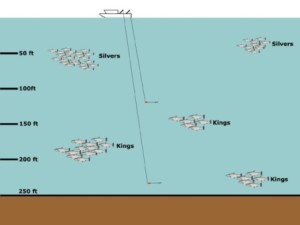 The vast majority of the salmon caught in Craig by sportfishers every summer are taken mooching. The method is quite simple in nature, yet it’s effectiveness is unbelievable. 6 foot leaders rigged with double hooks in either 3/0-4/0 or 4/0-5/0 are attached to a 4 to 6 ounce banana weight and with the boat moving forward slightly these rigs are then dropped at a controlled rate until they reach the bottom, or a predetermined cutoff depth. At that point the reel is kicked into gear and the herring is reeled slowly back to the surface where the bait can be checked before plummetting it back into the depths. Unlike other salmon fishing locales in the Pacific Northwest where salmon are feeding at a specific depth, salmon can be feeding at virtually any depth in the waters around Craig, thus the mooching method is a great way to cover the entire water column.
The vast majority of the salmon caught in Craig by sportfishers every summer are taken mooching. The method is quite simple in nature, yet it’s effectiveness is unbelievable. 6 foot leaders rigged with double hooks in either 3/0-4/0 or 4/0-5/0 are attached to a 4 to 6 ounce banana weight and with the boat moving forward slightly these rigs are then dropped at a controlled rate until they reach the bottom, or a predetermined cutoff depth. At that point the reel is kicked into gear and the herring is reeled slowly back to the surface where the bait can be checked before plummetting it back into the depths. Unlike other salmon fishing locales in the Pacific Northwest where salmon are feeding at a specific depth, salmon can be feeding at virtually any depth in the waters around Craig, thus the mooching method is a great way to cover the entire water column.
One critical element of this technique is the movement of the boat. A stationary boat will cause the baits to drop straight down, causing the herring and leader to wind up the line as the bait travels toward bottom. with a slight line angle this tangling can be avoided and the herring will travel out of the mainlines path as it drops.
Hookups mooching range from the “slamola” take to the fickle fish that pecks, licks, noses, fondles, and nudges the bait for what seems like an eternity before committing to the snack. Setting the hook prematurely in the latter situation results in bare hooks or a raked bait and ultimately a 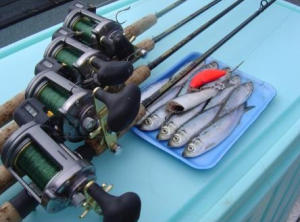 frustrated angler. Feeding a finicky fish line off the reel is usually the trick, or as is the case with silvers picking up the retrieve can sometimes get them to commit. Needless to say, unless the rod is pulled all the way down and held there the fish hasn’t committed to the bait and turned with it. This past summer John Posey of Lamiglas rods had a 48 pound king play with his bait for well over a minute before engulfing it. Boats working near us were goading John to set the hook, but he sweated it out and waited until the right time to lay into the king. A herring cut straight from the pack will work for mooching, but far and away the best results will be achieved by brining the baits. Rock salt is a good place to start and a typical solution would be two cups of salt for a gallon of water. On a normal charter when the fish are in we’ll go thru between 10 and 15 dozen herring in a day, meaning we’ll need to have at least 4 to 5 dozen baits cut and in the brine before leaving the dock in the morning. As baits run low we’ll add more as the day goes on. The brine solution found on Salmon University is also excellent for mooching.
frustrated angler. Feeding a finicky fish line off the reel is usually the trick, or as is the case with silvers picking up the retrieve can sometimes get them to commit. Needless to say, unless the rod is pulled all the way down and held there the fish hasn’t committed to the bait and turned with it. This past summer John Posey of Lamiglas rods had a 48 pound king play with his bait for well over a minute before engulfing it. Boats working near us were goading John to set the hook, but he sweated it out and waited until the right time to lay into the king. A herring cut straight from the pack will work for mooching, but far and away the best results will be achieved by brining the baits. Rock salt is a good place to start and a typical solution would be two cups of salt for a gallon of water. On a normal charter when the fish are in we’ll go thru between 10 and 15 dozen herring in a day, meaning we’ll need to have at least 4 to 5 dozen baits cut and in the brine before leaving the dock in the morning. As baits run low we’ll add more as the day goes on. The brine solution found on Salmon University is also excellent for mooching.
Getting to Craig
Our guests get to Craig by floatplane from Ketchikan with Pacific Airways. With travel time around 40 minutes the trip is short and the scenery spectacular. For those not wishing to fly the Inter Island Ferry out of Ketchikan makes two trips a day to Hollis on the east side Prince of Wales Island. A short 40 minute drive will get you to Craig from Hollis. Anglers bringing their own vessels to Craig from the lower 48 typically take the Alaska Ferry from Prince Rupert to Ketchikan, and then hop the smaller Inter Island Ferry over to Prince of Wales Island.
Smaller vessels are fine for fishing within the protected islands, but a stout vessel of 21 to 22 feet, minimum, is recommended for treks into the North Pacific. Most of the charter vessels in Craig are from 22 to 28 feet in length with full Alaska bulkheads, state of the art electronics, and safety gear. Flares, fire extinguishers, life jackets, bilge pumps, radios, electronics, and all other safety equipment need to be in good working condition at all times. Safety is of utmost concern and you’ll find just about every charter captain in town tuned into the weather report before each days sailing.
The one advantage to fishing out of Craig, however, is that the many islands that separate Craig from the ocean also provide protection from most any wind that comes up in the summer.
How to Fish for Salmon | How to Catch Salmon | How to Fish for Tuna | How to Catch Tuna | How to Fish for Halibut | How to Catch Halibut





